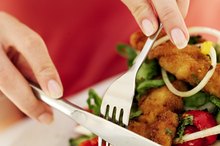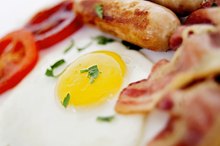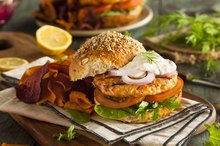What does fact checked mean?
At Healthfully, we strive to deliver objective content that is accurate and up-to-date. Our team periodically reviews articles in order to ensure content quality. The sources cited below consist of evidence from peer-reviewed journals, prominent medical organizations, academic associations, and government data.
- mayoclinic.com: Energy density and weight loss: Feel full on fewer calories
- americanheart.org: Know Your Fat
The information contained on this site is for informational purposes only, and should not be used as a substitute for the advice of a professional health care provider. Please check with the appropriate physician regarding health questions and concerns. Although we strive to deliver accurate and up-to-date information, no guarantee to that effect is made.
List of High-Density Foods
High-density foods are those that have a lot of calories per unit of weight 2 12. By contrast, low-density foods normally contain more water and are lower in calories. What this means is that high-density foods have a large amount of calories for a small volume of food. To measure a food's density, divide the number of calories per serving by the weight in grams per serving. Aim to eat more foods than have an energy density of two or less.
Dairy
Butter is one of the highest density foods you can eat because of the high fat content. One tsp. of butter contains nearly the same amount of calories as 2 cups of broccoli. Cream is similar to butter in that it has a very high fat content, which makes it a high-density food. Full fat milk and most cheeses are also examples of high-density foods.
- Butter is one of the highest density foods you can eat because of the high fat content.
- Cream is similar to butter in that it has a very high fat content, which makes it a high-density food.
Fatty Meats
Is Hummus a Low-Cholesterol Food?
Learn More
Fatty meats such as salami, pepperoni, sausage, and many cuts of beef are high-density foods. A normal serving size for a piece of meat is 4 oz., and the higher the fat content, the more calorie dense the food is. This is due to the fact that 1 gram of fat contains 9 calories, as opposed to only 4 calories each for 1 gram of protein.
Junk Food
In general, most foods that you think of as being "junk food" are high-density foods. It also includes sodas, sugary juices, and alcohol, as well as fast food, such as:
- hamburgers
- French fries
Most fried foods like chicken tenders, onion rings, and jalapeno poppers are high-density foods. Pizza can be considered junk food and can be high-density as well if you load it with cheese and fatty meats, but choosing a healthier pizza with whole wheat crust, low-fat cheese, and lots of vegetables instead of meats can make pizza a lower density food.
- In general, most foods that you think of as being "junk food" are high-density foods.
- Pizza can be considered junk food and can be high-density as well if you load it with cheese and fatty meats, but choosing a healthier pizza with whole wheat crust, low-fat cheese, and lots of vegetables instead of meats can make pizza a lower density food.
Carbohydrates and Oils
Free List of Healthy Low-Fat Foods
Learn More
Many carbohydrates, or starches, are high-density. Some of these include:
- potatoes
- pasta
- bagels
- bread
- rice,
- beans
Even though some of these are high-density, choosing whole grain carbohydrates (rather than refined or "white" carbs) is an essential part of a balanced diet and provides necessary vitamins and nutrients to your body. All oils are high-density because of the high fat content, but there are certain types of oils that are considered healthy, even though they're high in calories.
Related Articles
References
- medicinenet.com: Energy density is the key to healthy, high-volume eating
- mayoclinic.com: Energy density and weight loss: Feel full on fewer calories
- americanheart.org: Know Your Fat
- Centers for Disease Control and Prevention. Low-Energy-Dense Foods and Weight Management: Cutting Calories While Controlling Hunger.
- Hill JO, Wyatt HR, Peters JC. Energy Balance and Obesity. Circulation. 2012;126(1):126-132. doi:10.1161/CIRCULATIONAHA.111.087213
- U.S. Department of Agriculture. ChooseMyPlate. Dietary Guidelines for Americans 2015–2020.
- Kowal-Connelly S. American Academy of Pediatrics. How Children Develop Unhealthy Food Preferences. Updated August 27, 2020.
- Daniels MC, Popkin BM. Impact of water intake on energy intake and weight status: a systematic review. Nutr Rev. 2010;68(9):505-521. doi:10.1111/j.1753-4887.2010.00311.x









